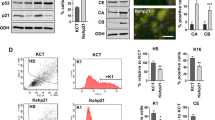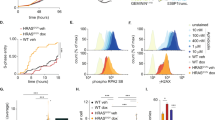Abstract
The p53/p21Cip1/Waf1-dependent checkpoint control of G1/S and G2/M phases of the cell cycle in response to DNA damage is an important mechanism of genome stability maintenance in normal cells. In many tumor cells, due to frequent point mutations and deletions of p53, the stringent control of the cell cycle and apoptosis is compromised. We have examined the cell cycle control and cell death of the rat embryo fibroblast cells (REF) transformed by E1A+cHa-ras oncogenes and expressing wild type p53. Gamma-irradiation at a dosage of 6 Gy has been used to analyse the p53-dependent trans-activation of the target p21cip1/waf1 gene and the levels of activity of cyclin-dependent kinases. Our results show that the cell cycle inhibitors p21Cip1/Waf1 and p27KIP accumulate in response to irradiation both in REF and E1A+cHa-ras cells. In contrast to normal REF cells, the accumulation of p21Cip1/Waf1 and p27KIP inhibitors, however, does not lead to inhibition of Cdk2 and cyclins E, A-associated kinase activities and to a G1/S block in E1A+cHa-ras cells. It is unlikely that the lack of inhibitory function of p21Cip1/Waf1 can be explained by its inability to bind Cdk2 and Cdk4 kinases or PCNA. Moreover, the p21Cip1/Waf1-associated kinase activity is increased upon γ-irradiation of E1A+cHa-ras cells. We suggest that inactivation of p21Cip1/Waf1 may be accounted for by its interaction with E1A oncoproducts as the inhibitor is detected in immunoprecipitates using E1A-specific antibodies. During a temporary G2/M delay induced by γ-irradiation, E1A+cHa-ras transformants continue DNA replication, which leads to accumulation of polyploid cells with lobulated nuclei and micronuclei. Thus, DNA damage of E1A+cHa-ras transformed cells, with a combination of functionally active wild type p53 and inactive p21Cip1/Waf1, contributes to formation of polyploid cells which then die due to apoptosis.
This is a preview of subscription content, access via your institution
Access options
Subscribe to this journal
Receive 50 print issues and online access
$259.00 per year
only $5.18 per issue
Buy this article
- Purchase on Springer Link
- Instant access to full article PDF
Prices may be subject to local taxes which are calculated during checkout






Similar content being viewed by others
References
Bartek J, Bartkova J and Lucas J. . 1996 Curr. Opin. Cell. Biol. 8: 805–814.
Bouchou T, Krannenburg O, van Dam H, Roelen D, Zantema A, Hall FL and van der Eb AJ. . 1993 Oncogene 8: 1765–1773.
Bradford MM. . 1976 Analyt. Biochem. 72: 248–254.
Bulavin DV, Kurash YK, Aksenov ND, Pospelov VA and Pospelova TV. . 1998 Mol. Biol. (Russ) 32: 703–711.
Bunz F, Dutriaux A, Lengauer C, Waldman T, Zhou S, Brown JP, Sedivy JM, Kinzler KW and Vogelstein B. . 1998 Science 282: 1497–1501.
Chomczynski P and Sacchi N. . 1987 Analyt. Biochem. 162: 156–159.
De Gregory J, Kovalik T and Nevins JR. . 1995 Mol. Cell. Biol. 15: 4215–4224.
Deng C, Zhang P, Harper JW, Elledge SJ and Leder P. . 1995 Cell 82: 675–684.
Duyndam MCA, van Dam H, van der Eb A and Zantema A. . 1996 J. Virol. 70: 5852–5859.
El-Deiry WS, Tokino T, Velculescu VE, Levy DB, Parsons R, Trent JM, Lin D, Mercer E, Kinzler KW and Vogelstein B. . 1993 Cell 75: 817–825.
Funk JO, Waga S, Harry JB, Espling E, Stillman B and Galloway DA. . 1997 Genes Dev. 11: 2090–2100.
Graham FL and van der Eb AJ. . 1973 Virology 54: 536–539.
Grana X, Garriga J and Mayol X. . 1998 Oncogene 17: 3365–3383.
Jacks T and Weinberg RA. . 1996 Nature 381: 643–644.
Jones DL, Alani RM and Munger K. . 1997 Genes Dev. 11: 2101–2111.
King RW, Deshaies RJ, Peters J-M and Kirscher MW. . 1996 Science 247: 1652–1658.
Krannenburg O, Keblusek P, van der Eb AJ and Zantema A. . 1992 J. Virol. 70: 7804–7810.
Lin H-JL, Eviner V, Prendergast GC and White E. . 1995 Mol. Cell. Biol. 15: 4536–4544.
Lowe SW, Ruley HE, Jacks T and Housman DE. . 1993 Cell 74: 957–967.
Ludberg AS and Weinberg RA. . 1998 Mol. Cell Biol. 18: 753–761.
Mal A, Poon RC, Howe Ph, Toyoshima H, Hunter T and Harter ML. . 1996 Nature 380: 262–265.
Nakajima T, Morita K, Tsunoda H, Imajoh-Ohmi S, Tanaka H, Yasyda H and Oda K. . 1998 J. Biol. Chem. 273: 20036–20045.
Nevins JR. . 1992 Science 258: 424–429.
Niculescu III AB, Chen X, Smeets M, Hengst L, Prives C and Reed SI. . 1998 Mol. Cell. Biol. 18: 629–643.
Orlovskaya EI, Kislyakova TV, Osipov KA, Malashicheva AB and Pospelov VA. . 1997 Mol. Biol. (Russ.) 31: 224–231.
Poon RYC and Hunter T. . 1998 Oncogene 16: 1333–1343.
Pospelov VA, Pospelova TV and Julien J-P. . 1994 Cell Growth Differ. 5: 187–196.
Rao L, Debass M, Sabbatini P, Hockenberry D, Korsmeyer S and White E. . 1992 Proc. Natl. Acad. Sci. USA 89: 7742–7746.
Sabbatini P, Chion SK, Rao L and White E. . 1995 Mol. Cell. Biol. 15: 1060–1070.
Schreiber E, Matthias P, Muller MM and Schaffner W. . 1989 Nucl. Acids Res. 17: 6419.
Sekia T, Prassolov VS, Fushimi M and Nishimura S. . 1985 Jpn. J. Cancer Res. 76: 851–855.
Serrano M, Lin AW, McCurrach ME, Beach D and Lowe SW. . 1997 Cell 88: 593–602.
Spitkovsky D, Steiner P, Lukas J, Lees E, Pegano M, Schutze A, Joswig S, Picard P, Tommasini M, Eilers M and Jansen-Durr P. . 1994 J. Virol. 72: 975–985.
Waldman T, Kinzler KW and Vogelstein B. . 1995 Cancer Res. 55: 5187–5190.
Waldman T, Lengauer C, Kinzler KW and Vogelstein B. . 1996 Nature 381: 713–716.
White E. . 1993 Proc. Soc. Exp. Biol. Med. 204: 30–39.
Xiong Y, Hannon GJ, Zhang H, Casso D, Kabayashi R and Beach D. . 1993 Nature 366: 701–704.
Zerfass K, Spitkovksy D, Shultze A, Joswig S, Henglein B and Jansen-Durr P. . 1996 J. Virol. 70: 2637–2642.
Acknowledgements
We thank Josephine Dorsman, Hans van Ormondt, Alt Zantema and Alex van der Eb for help and valuable discussions. We are also indebted to Alt Zantema for antibodies to Cdk2, Edward Harlow for E1A antibodies and WS El-Deiry for plasmids PG13-Luc, MG15-Luc. We acknowledge to Marina Tarunina for help in sequencing of p53 cDNA and Eugene Kroll for critical reading of manuscript. This work was supported in part by the Russian Fund for Basic Research (grants 98-04-49936 and 97-04-50199), by the Program `National Priorities in Medicine and Health' and by the INTAS grant 94-4409.
Author information
Authors and Affiliations
Rights and permissions
About this article
Cite this article
Bulavin, D., Tararova, N., Aksenov, N. et al. Deregulation of p53/p21Cip1/Waf1 pathway contributes to polyploidy and apoptosis of E1A+cHa-ras transformed cells after γ-irradiation. Oncogene 18, 5611–5619 (1999). https://doi.org/10.1038/sj.onc.1202945
Received:
Revised:
Accepted:
Published:
Issue Date:
DOI: https://doi.org/10.1038/sj.onc.1202945
Keywords
This article is cited by
-
A limited role for p53 in modulating the immediate phenotype of Apc loss in the intestine
BMC Cancer (2008)
-
Caspase independence of radio-induced cell death
Oncogene (2006)
-
Additive effect of p53, p21 and Rb deletion in triple knockout primary hepatocytes
Oncogene (2004)
-
Inactivation of the Wip1 phosphatase inhibits mammary tumorigenesis through p38 MAPK–mediated activation of the p16Ink4a-p19Arf pathway
Nature Genetics (2004)
-
Transient expression of E1A and Ras oncogenes causes downregulation of c-fos gene transcription in nontransformed REF52 cells
Oncogene (2003)



